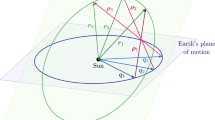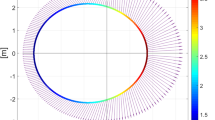Abstract
A combined analytical-numerical procedure for determining mean orbital elements is presented and applied to the orbits of GEOS 1 and GEOS 2. The precision of the mean semi-major axes of these orbits is a few tens of centimeters when optical flash data are used to determine 2 day orbital arcs. Four day Minitrack orbits give mean semi-major axes of a few meters precision. The mean orientation parameters (i, Ω) determined from the optical data are obtained to a precision of about 0″.1.
Similar content being viewed by others
References
Gaposchkin, E. M. and Lambeck, K.: 1969,Smithsonian Astrophysical Observatory Special Report No. 315, Cambridge, Mass.
Kaula, W. M.: 1966,Theory of Satellite Geodesy, Blaisdell, Waltham, Mass.
Marsh, J. G. and Douglas, B. C.: 1971,Celes. Mech. 4, 309–328.
Marsh, J. G., Douglas, B. C., and Klosko, S. M.: 1971, ‘A Unified Set of Tracking Station Coordinates Derived from Geodetic Satellite Tracking Data’, Goddard Space Flight Center Report No. X-553-71-370.
Author information
Authors and Affiliations
Rights and permissions
About this article
Cite this article
Douglas, B.C., Marsh, J.G. & Mullins, N.E. Mean elements of GEOS 1 and GEOS 2. Celestial Mechanics 7, 195–204 (1973). https://doi.org/10.1007/BF01229947
Received:
Issue Date:
DOI: https://doi.org/10.1007/BF01229947




